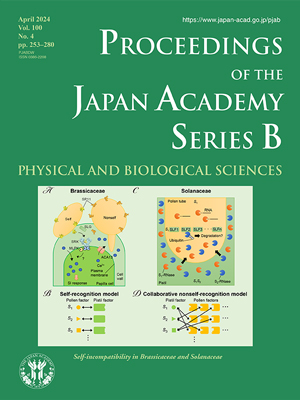About the Cover
Vol. 100 No. 4 (2024)
Self-incompatibility (SI) is a breeding system that promotes outbreeding to maintain genetic variation within a species. SI is also important in agriculture because its nature is often used in the production of F1 hybrid seeds. SI is basically controlled using a single locus with multiple alleles (S1, S2, ...,Sn). The S-locus encodes two genes, pistil and pollen factors, and the specific interactions of these factors regulate SI reactions. Since Darwin’s detailed observations in 19th century, how plants recognize self and nonself had been a mystery. The authors of this issue (pp. 264–280) reviewed 40 years of research on SI and uncovered the molecular mechanisms of self-/nonself-recognition in SI of Brassicaceae and Solanaceae.
The cover illustration summarizes the molecular mechanisms of SI in Brassicaceae and Solanaceae. Kokichi Hinata’s group conducted advanced research on SI in Brassicaceae using genetic approaches. The authors began collaboration with Hinata’s group in the early 1980s and revealed receptor kinase SRK and its ligand SP11 as the pistil and pollen factors, respectively. SP11 on the pollen specifically binds cognate SRK on the papilla cell and trigger subsequent reactions in the papilla cell (Fig. A). As a result, the self-pollen cannot germinate, whereas nonself-pollens are not recognized by SRK, resulting in germination. Thus, Brassicaceae SI can be explained by “self-recognition” model (Fig. B).
The authors started research on SI in Solanaceae in the mid-1990s. In this plant species, the pistil factor is a ribonuclease named S-RNase. S-RNase accumulates in the style and degrades the RNA of the pollen tubes. As the pollen factors, up to 18 SLF (SLF1–18) genes were found in the Solanaceae S-locus. SLFs are F-box proteins that detoxify target S-RNases via a ubiquitin-proteasome pathway. The authors found that these SLFs collectively recognize and degrade all nonself S-RNases, and subsequently, these pollen tubes can continue elongation through the style. However, any of the many self-SLFs cannot recognize self-S-RNase, and RNA of the self-pollen is degraded (Fig. C). Therefore, the Solanaceae SI system is explained by the “collaborative nonself-recognition” model (Fig. D).
Thus, the authors revealed the diversity of SI systems in plants. These studies will contribute to future studies to understand other self-/nonself-recognition systems in plant reproduction.
Tsuneyoshi Kuroiwa
Member of the Japan Academy




